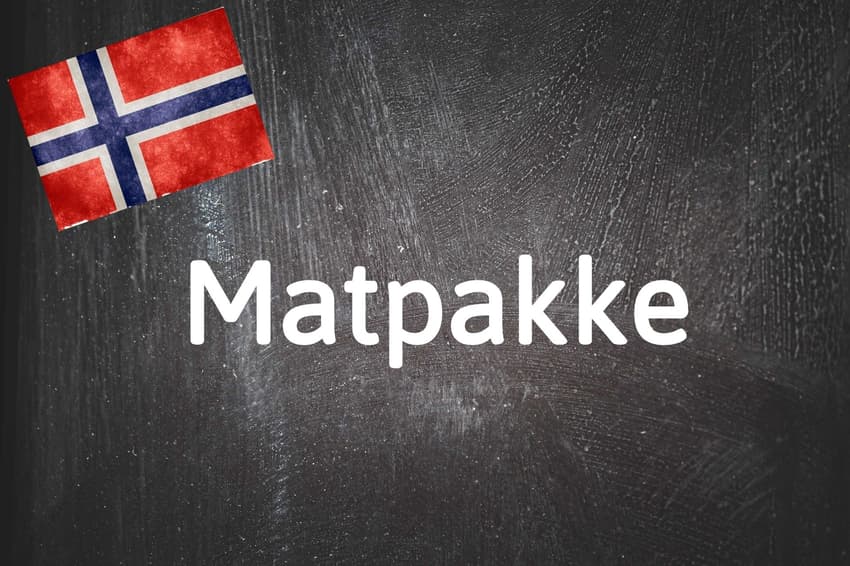Norwegian word of the day: Matpakke

The humble 'matpakke' may be a simple word to learn, but the daily tradition gives a big insight into Norway.
What does it mean?
Directly translated, this means "food package". What it actually means is packed lunch. It applies to any meal you bring with you to work, pack for your kids to take to school or take on a hike.
However, while it may mean packed lunch, it's typically referring to the traditional bread with some kind of pålegg combo and accompanied by some sort of fruit or veg. Pålegg in itself is a unique and almost untranslatable word. It means "on-layer" but refers to anything you'd put on top of a slice of bread.
This encompasses everything from smoked fish to peanut butter and cheese and meats. To learn more about pålegg, click here.
The slices of bread and spread are normally separated with matpapir (food paper) to stop them from making a mess and sticking together.
Why do I need to know this?
The matpakke is a part of many Norwegians' daily routine. Some would even go as far as to call it a tradition or rite of passage.
Many will have the same packed lunch over and over again with little variation. Why Norwegians do this isn't clear, and as Norwegians aren't overly impressed with my habit of combining butter and mayo on the base layer, they may take exception to me asking. If you do know, get in touch!
One explanation for this may be that eating out in Norway is expensive, meaning many are unlikely to head out for a warm lunch most days.
Another explanation is that for all of Norway's work-life balance and generous salaries, the typical lunch break is only half an hour.
And our final theory, would be that Norwegians may not have the stomach for a full hot meal as they tend to have lunch rather early.
Use it like this
Jeg har pakket to matpakker til oss for turen i dag.
(I have packed two lunches for our trip today.)
Hva har du på matpakka I dag?
(What do you have on your packed lunch today?)
Lise, skal du være med å spise lunsj I kantina I dag?
(Lise, are you coming to eat lunch in the canteen today?)
Nei takk, jeg har med matpakke.
(No thanks, I have my packed lunch)
Comments
See Also
What does it mean?
Directly translated, this means "food package". What it actually means is packed lunch. It applies to any meal you bring with you to work, pack for your kids to take to school or take on a hike.
However, while it may mean packed lunch, it's typically referring to the traditional bread with some kind of pålegg combo and accompanied by some sort of fruit or veg. Pålegg in itself is a unique and almost untranslatable word. It means "on-layer" but refers to anything you'd put on top of a slice of bread.
This encompasses everything from smoked fish to peanut butter and cheese and meats. To learn more about pålegg, click here.
The slices of bread and spread are normally separated with matpapir (food paper) to stop them from making a mess and sticking together.
Why do I need to know this?
The matpakke is a part of many Norwegians' daily routine. Some would even go as far as to call it a tradition or rite of passage.
Many will have the same packed lunch over and over again with little variation. Why Norwegians do this isn't clear, and as Norwegians aren't overly impressed with my habit of combining butter and mayo on the base layer, they may take exception to me asking. If you do know, get in touch!
One explanation for this may be that eating out in Norway is expensive, meaning many are unlikely to head out for a warm lunch most days.
Another explanation is that for all of Norway's work-life balance and generous salaries, the typical lunch break is only half an hour.
And our final theory, would be that Norwegians may not have the stomach for a full hot meal as they tend to have lunch rather early.
Use it like this
Jeg har pakket to matpakker til oss for turen i dag.
(I have packed two lunches for our trip today.)
Hva har du på matpakka I dag?
(What do you have on your packed lunch today?)
Lise, skal du være med å spise lunsj I kantina I dag?
(Lise, are you coming to eat lunch in the canteen today?)
Nei takk, jeg har med matpakke.
(No thanks, I have my packed lunch)
Join the conversation in our comments section below. Share your own views and experience and if you have a question or suggestion for our journalists then email us at [email protected].
Please keep comments civil, constructive and on topic – and make sure to read our terms of use before getting involved.
Please log in here to leave a comment.